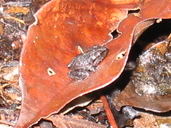|
Description
Craugastor rhodopis is a frog with an adult snout-vent length range of 23.82 - 30.43 mm in males and 36.77 - 42.33 mm in females (Streicher et al. 2014).
Craugastor rhodopis can typically be differentiated from the other two species of the C. rhodopis Species Group as follows (character condition in parentheses): Unlike C. loki, C. rhodopis has a relatively long shank typically more than 56% of the snout-vent length (typically less than 54% of the snout-vent length). Unlike C. occidentalis, C. rhodopis has a small supratympanic fold that is typically subtended by two tubercles (‘Y-shaped’ supratympanic fold) (Streicher et al. 2014).
This species is highly polymorphic in its coloration. Individuals of this species typically possess a masque extending in some individuals from the canthus to the posterior side of the tympanum and in others being restricted to the posterior side of the tympanum. Dorsal ground color occurs in varying shades of grey, orange, tan or brown. The dorsum is highly glandular and typically there are no dark blotches associated with individual glands, as in C. occidentalis. Dorsal ridges are present and more prominent than in C. loki, but not as prominent as in C. occidentalis. Some individuals have a mid-dorsal stripe varying from thin to thick, or tan dorsolateral stripes. A solid tapered dorsum coloration is sometimes observed in specimens of C. rhodopis (Chromatotype of Eleutherodactylus dorsoconcolor). As observed in C. occidentalis, specimens of C. rhodopis can have white arms and/or a distinctive white upper labium (chromatotype of Syrrhophus mystaceus; Streicher et al. 2014).
Males sometimes had proportionally larger tympana than females (Streicher et al. 2014). Distribution and Habitat
Country distribution from AmphibiaWeb's database: Belize, El Salvador, Guatemala, Mexico
This highland species occurs in the Sierra Madre Oriental range of eastern Mexico. Populations are known from pine-oak forest habitat in the states of San Luis Potosí, Hidalgo, Veracruz and Puebla at elevations of 1258 - 1862 m (Streicher et al. 2014). Life History, Abundance, Activity, and Special Behaviors
Known to prey upon annelids (Aguilar-López and Pineda 2013). Larva
Presumably direct developing like other members of the genus Craugastor. Trends and Threats
Craugastor rhodopis is potentially impacted by agricultural practices (Lara-Tufiño et al. 2019). The species also lives in leaf litter of montane environments where logging often occurs (IUCN 2020). Comments
Bayesian and Maximum Likelihood analysis of 12s mtDNA found that C. loki is sister to C. rhodopis and together they are sister to C. occidentalis. However, the amount of sequence divergence within each species indicate that there may be more potential taxonomic subdivision (Streicher et al 2014).
From Streicher et al. (2014, with permission from the first author):
Craugastor rhodopis may have one of the more complex taxonomic histories for a Mexican amphibian. The original description of Craugastor rhodopis is attributed to Cope, who based his descriptions on four syntypes USNM 16557 - 60. Kellogg (1932) designated USNM 16558 as the lectotype. The original description places the type locality at Orizava (= Orizaba) and Cordova (= Córdoba), Veracruz, but this was later restricted to Orizaba by Smith and Taylor (1950). Two species were described from the vicinity of Jalapa (= Xalapa), Veracruz, Hylodes plicatus and H. venustus. Barbour (1922) described two additional forms from just west of Xalapa (specifically a locality he referred to as Cerro de los Estropajos), Syrrhophus mystaceus and Eleutherodactylus dunnii (spelled dunni by several subsequent authorities [e.g. Shannon and Werler 1955]) were both later considered junior synonyms of C. rhodopis by Kellogg (1932) and Lynch (1966), respectively. Eleutherodactylus dorsoconcolor was described by Taylor (1941) from Tequeyutepec, Veracruz about 7 miles west of Xalapa, which Duellman (1960) placed in the synonymy of C. rhodopis.
References
Aguilar-López, J.L. and Pineda, E. (2013). An exotic species of earthworm preyed by Craugastor rhodopis (Anura: Craugastoridae) in Mexico. Herpetology Notes 6: 335-336.
[link]
Barbour, T. (1922) Three new neotropical Salientia. Proceedings of the Biological Society of Washington 35: 111–114.
[link]
Cope, E.D. (1867) “1866” Fifth contribution to the herpetology of tropical America. Proceedings of the Academy of Natural Sciences of Philadelphia 18: 317–323.
[link]
Duellman, W.E. (1960) A distributional study of the amphibians of the Isthmus of Tehuantepec, Mexico. University of Kansas Publications Museum of Natural History 13: 19–72.
[link]
IUCN SSC Amphibian Specialist Group. 2020. Craugastor rhodopis. The IUCN Red List of Threatened Species 2020: e.T56910A53966854. https://dx.doi.org/10.2305/IUCN.UK.2020-3.RLTS.T56910A53966854.en. Accessed on 28 November 2023.
Kellogg, R. (1932) Mexican tailless amphibians in the United States National Museum. Bulletin of the United States National Museum 160: 1–224.
[link]
Lara-Tufiño, J.D., Badillo-Saldaña, L.M., Hernández-Austria, R. and Ramírez-Bautista, A. (2019). Effects of traditional agroecosystems and grazing areas on amphibian diversity in a region of central Mexico. PeerJ 7: e6390.
[link]
Lynch, J.D. (1966) Multiple morphotypy and parallel polymorphisms in some neotropical frogs. Systematic Zoology 15: 18–23.
[link]
Shannon, F.A. and Werler, J.E. (1955) Notes on amphibians of the Los Tuxtlas range of Veracruz. Transactions of the Kansas Academy of Sciences 58: 360–386.
[link]
Smith, H.M. and Taylor, E.H. (1950) Type localities of Mexican reptiles and amphibians. University of Kansas Science Bulletin 33: 313–380.
[link]
Streicher, J.W., García-Vázquez , U.O., Ponce-Campos, P., Flores-Villela, O., Campbell, J.A. and Smith, E.N. (2014) Evolutionary relationships amongst polymorphic direct-developing frogs in the Craugastor rhodopis species group (Anura: Craugastoridae). Systematics and Biodiversity 12(1), 1–22.
[link]
Originally submitted by: Jeffrey W. Streicher (2023-12-12)
Edited by: Ann T. Chang (2023-12-12)Species Account Citation: AmphibiaWeb 2023 Craugastor rhodopis: Polymorphic Leaf-litter Frog <https://amphibiaweb.org/species/3172> University of California, Berkeley, CA, USA. Accessed Nov 12, 2024.
Feedback or comments about this page.
Citation: AmphibiaWeb. 2024. <https://amphibiaweb.org> University of California, Berkeley, CA, USA. Accessed 12 Nov 2024.
AmphibiaWeb's policy on data use.
| 




 Map of Life
Map of Life